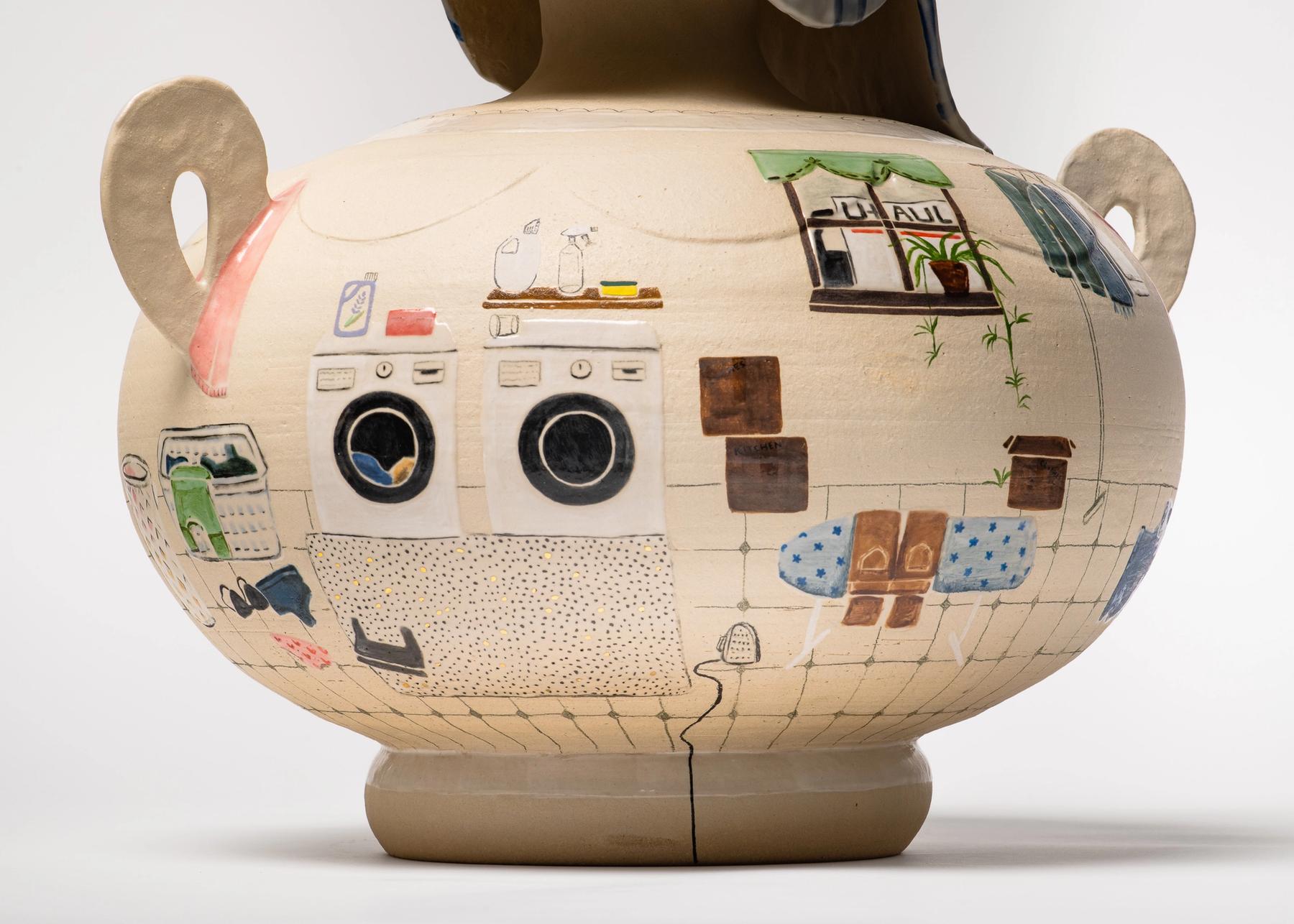
What year did/will you graduate from MECA&D, and what did/do you study? OR What do you teach at MECA&D?
I just graduated from MECA&D in 2024, and I earned my BFA in ceramics.
What artistic media do you primarily work with, and what drew you to them? Do you feel they lend themselves to exploring queer narratives?
As a ceramicist, I continuously explore clay’s capacity to archive stories, culture, and memories through its material endurance. I am drawn to the impermanence of clay and the cultural importance it signifies across the globe. So, by visually representing and exploring themes of modern queer culture in my ceramics, the spaces, objects, and histories are solidified through the material. I believe that queer life, including the intimate and quiet moments, is worth celebrating and remembering. Therefore, my work commemorates the unseen and forgotten spaces in the sapphic community.
How does your lived experience influence or shape your artistic practice and the themes you explore in your work?
Growing up in the Midwest, I had very little awareness of sapphic people and the queer community at large. That said, my practice is driven to share the quieter aspects of queer culture. I want to make work that represents the most honest and fulfilling parts of my life for my community.
What are some of the biggest influences on your work? How does your community impact your artistic voice and vision?
My work is primarily influenced by my partner, Charlotte Hardy (Animation & Game Art, Class of 2024), and our home that we have built together over the last few years. As we have grown alongside each other, our artistic practices and aspirations have melded together, and we are consistently encouraging one another to keep making. Our home, the objects in it, as well as our queer friends' homes in Portland have largely influenced my work and will continue to do so as I look forward to a handful of residencies this upcoming year.

How does your work fit in (or not fit in) to the narratives of art history?
As an artist actively working with a very permanent material, I am constantly aware of time and longevity. So, I strive to create work that feels genuine to myself and my experiences so that in the future, there could be a deeper understanding of queer culture from our time while also creating conversations around the underrepresented aspects of queerness now.
How has your experience with the College impacted the way you relate to your identity?
MECA&D has an incredible queer community. Through my peers, professors, and staff, I learned a lot about myself through shared experiences. Most importantly, I learned that my identity never has to be stagnant, that it can grow and change as I do, and that those changes are exciting.
What do you see as the future of queer art and its role in broader cultural conversations around LGBTQIA+ issues?
Camp has always been, and always will be, the future of queer art. Camp, and drag specifically, is dramatically self-aware, glamorous, beautifully ridiculous, and always looking to push the boundaries of what is considered “good taste.” From the Club Kids to current popular artists like Chappell Roan and Sasha Velour, drag questions societal norms and opens many doors to what queerness could look like. Even though my work has quieter themes, I will always support drag and camp artists for their art and the conversations they initiate within the queer community.

Olivia Propeck '24, Laundry Room, Stoneware, 18" x 24" x 26", 2024
What are some of the recurring motifs, symbols, narratives, or themes that appear in your work, and what significance do they hold — particularly in relation to queer themes and experiences? How do they counter narratives of heteronormativity?
In most of my pieces, I include various sapphic symbolism—including violets and lavender flowers, the pink triangle, the U-HAUL logo, carabiners, and clothing that my partner and I share, to name a few. My current favorite is an oat milk carton. All of these objects and symbols are representations of objectively queer-coded material culture. So, by putting many of these objects into a body of work, the symbols help the audience understand the interior scenes as sapphic spaces. To a heteronormative audience, they might look like average home interiors on vases. However, the inclusion of the sapphic symbols caters the pieces specifically to the queer community, and I often describe these pieces as, “if you know, you know.”
Do you see your work as a method of resistance? If so, how does that resistance manifest itself in your work?
I don’t often think about my pieces as an act of resistance. I am trying to make the statement that sapphic spaces are natural and joyful. I don’t view my work as resisting domestic heteronormative spaces, but instead, I hope to share the desire that most people have—which is to be loved for who they are, to express themselves freely in their dwellings, and to be accepted as such. Granted, my pieces include sapphic-specific symbolism, which some could interpret as resistance. However, I hope my work unifies the human experience rather than highlighting our differences.
What are the most fulfilling or gratifying aspects of the creative process for you?
Making work about my partner and our life together is incredibly gratifying and fulfilling! She inspires and pushes me to follow my passion, and I am so incredibly thankful for that. In addition, the feedback from peers, family, and friends has also been so valuable to me. I hope, more than anything, they can see the life that I have grown to love, filled with so much happiness. Even though life and relationships aren’t always easy or joyful, I am proud of the home my partner and I have created together.